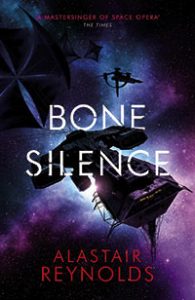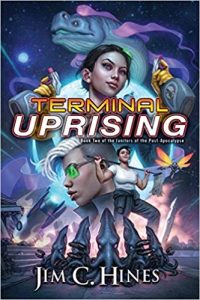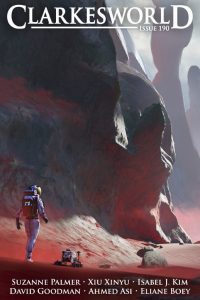Russell Letson Reviews Bone Silence by Alastair Reynolds
 Bone Silence, Alastair Reynolds (Gollancz 978-0575090675, $23.83, 496pp, hc) January 2020.
Bone Silence, Alastair Reynolds (Gollancz 978-0575090675, $23.83, 496pp, hc) January 2020.
With Bone Silence, Alastair Reynolds completes the far, far-future adventures of Arafura and Adrana Ness, a pair of nice girls who ran away from home to find adventure and got rather more than they expected. In Revenger it was crewing on a sunjamming, treasure-hunting spacecraft; pawing through caches of ancient lost technology in dangerous, widely scattered troves called “baubles”; and enduring kidnapping and brainwashing and assorted nastiness at the hands of the notorious pirate Bosa Sennen. In Shadow Captain it was leading a crew of privateers on the captured pirate ship (now renamed Revenger), dodging the authorities (who don’t distinguish much between “honest privateers” and pirates), and dealing with the gaudy crime boss of a down-at-the-heels habitat.
Bone Silence turns up the danger and intensity of the sisters’ situation. Events at the end of Shadow Captain – in particular the de/revaluing of the system-wide currency – have gotten the full and angry attention of the Powers That Be, who conflate the sisters with Bosa Sennen and send a whole fleet in pursuit of them, under the command of a particularly able and ruthless – not to say sadistic – young commodore. Once again the sisters are separated: Adrana undertakes to deliver an alien fugitive to a far-off habitat in a co-opted – actually, captured – ship, while Arafura draws their pursuers away in the Revenger. Each encounters a different set of hazards and mysteries and exotic characters – Arafura’s primarily of the space-opera variety as she dodges and engages the pursuing fleet, and Adrana’s of the space-habitat version of a mean-streets crawl.
This is perfectly good adventure-stuff: colorful crew members, encounters with assorted crooks and spies, space combat, chases and escapes and betrayals. The enduring appeal for me is the setting, starting with the immediate environments of steampunkish solar-sailing spacecraft, all rigging and rivets and water-cooled coil-guns; or the tatty corridors and conduits and drinking-dens of ancient habitats. Even the more respectable kinds of stations are far from the sterile, molded-white-plastic modernism of Kubrick’s 2001. Visiting the “laceworld” of Mulgracen (“a sort of sugary confection, made up of many thin and brittle layers, each nested delicately within each other”), Arafura encounters
Brake dust, pavement dirt, animal grease, monkey sweat, hot oil, electric fumes, kitchen smells, sewerage stink, the vinegar-tang of a drunk stumbling out of a nearby bar, the steam of an all-night laundry…. It was as fine and thrilling to her senses as a perfumery or chocolatier. She had missed the smell of cities. She had missed the smell of worlds, of life.
All this in a solar system that has, ten million years from now, been completely de- and reconstructed, all the planets broken up to build the Congregation that is the home of humankind and of various alien species – swarms of orbiting habitats of all shapes and sizes and styles. The latest civilization – or Occupation – is the half-ignorant inheritor of a dozen previous rise-decline-and-fall cycles, some of them responsible for the near-magical objects hidden away in the baubles, along with hoards of the strange objects called “quoins” that serve as the Congregation’s currency. The sisters (as well as the reader) puzzle over mysteries practical and general, particularly the real nature and function of quoins; what the various aliens are up to in human space and why; and the causes of the rise-and-fall pattern of the Occupations. Then there are the everyday mysteries of the operation of ancient technologies such as the communicator skulls; the eerie, neuro-computational “twinkly;” the infectious, invasive “glowy;” and the “ghostie” armor and blades that seem to have minds of their own. Some very large questions do get answers by the time the various quests are completed and identities are sorted out and conspiracies are uncovered, but others hover in the atmosphere.
It’s an extravagant, atmospheric, and mysterious world, a concoction of space opera, film noir, and a pulpified version of Stapledonian deep time that stretches beyond the limits of the page. In the Acknowledgements, Reynolds writes that he is “for the time being, done with the Ness sisters.” Even if they don’t return, their world is one that would be worth revisiting.
Russell Letson, Contributing Editor, is a not-quite-retired freelance writer living in St. Cloud, Minnesota. He has been loitering around the SF world since childhood and been writing about it since his long-ago grad school days. In between, he published a good bit of business-technology and music journalism. He is still working on a book about Hawaiian slack key guitar.
This review and more like it in the April 2020 issue of Locus.
 While you are here, please take a moment to support Locus with a one-time or recurring donation. We rely on reader donations to keep the magazine and site going, and would like to keep the site paywall free, but WE NEED YOUR FINANCIAL SUPPORT to continue quality coverage of the science fiction and fantasy field.
While you are here, please take a moment to support Locus with a one-time or recurring donation. We rely on reader donations to keep the magazine and site going, and would like to keep the site paywall free, but WE NEED YOUR FINANCIAL SUPPORT to continue quality coverage of the science fiction and fantasy field.








